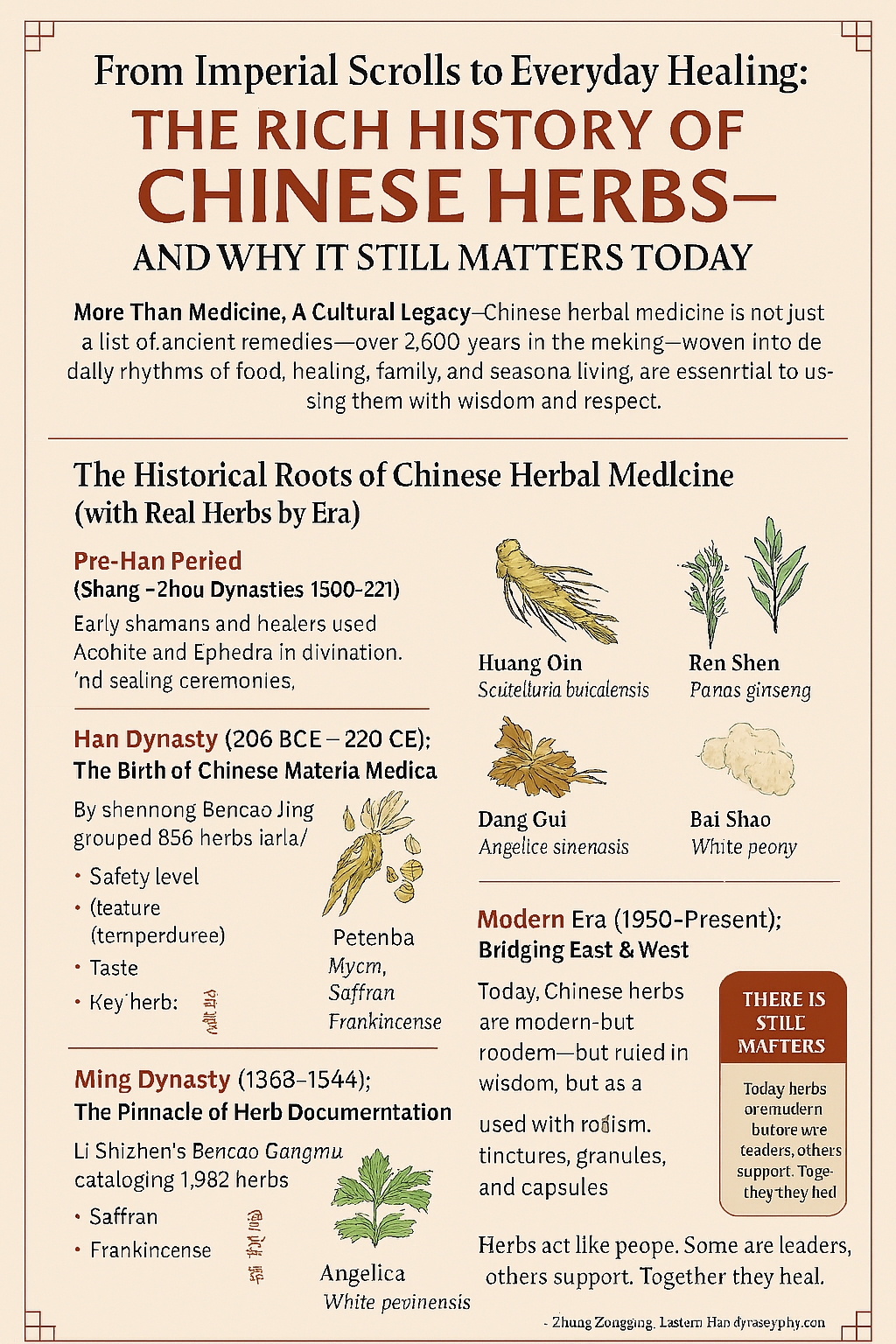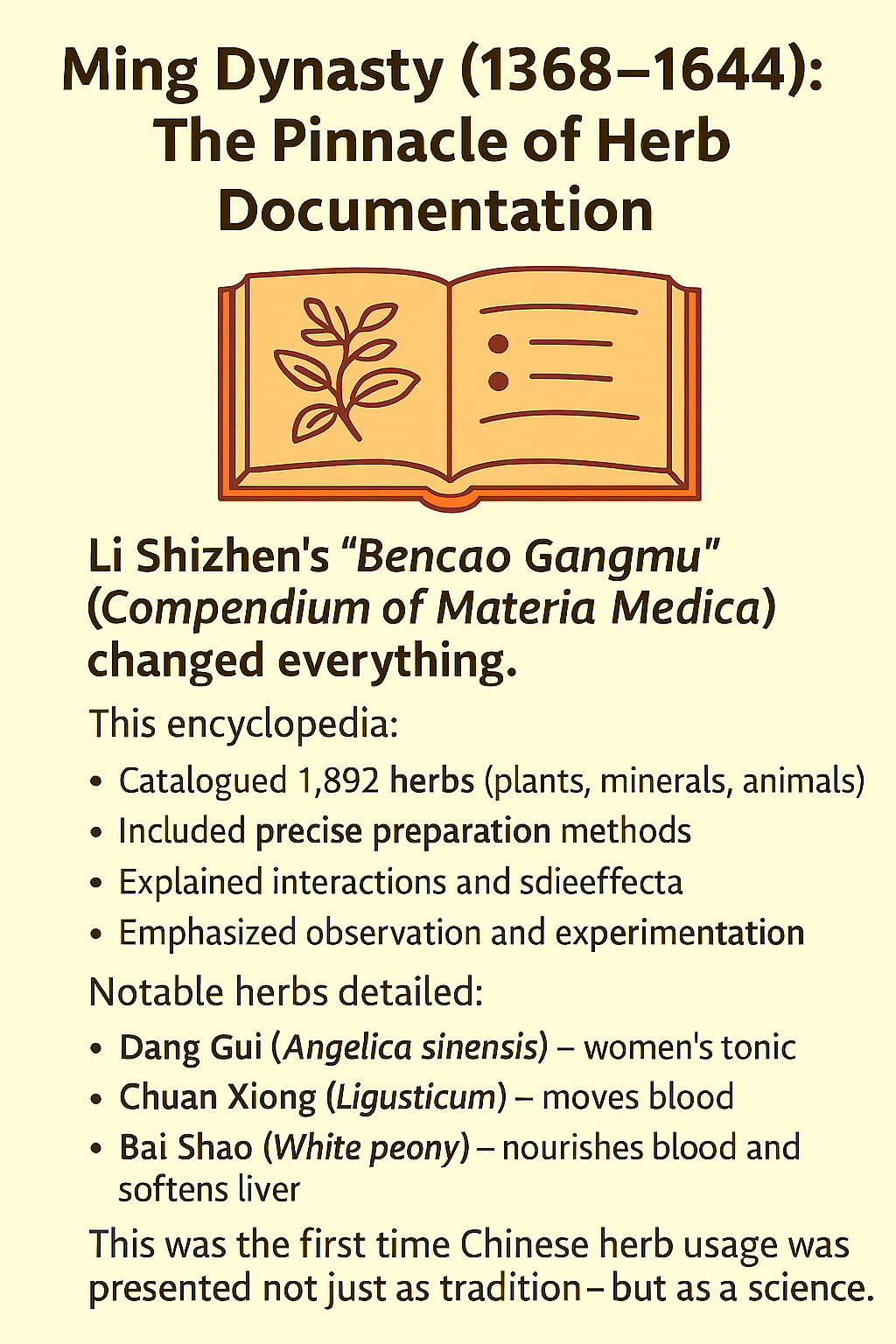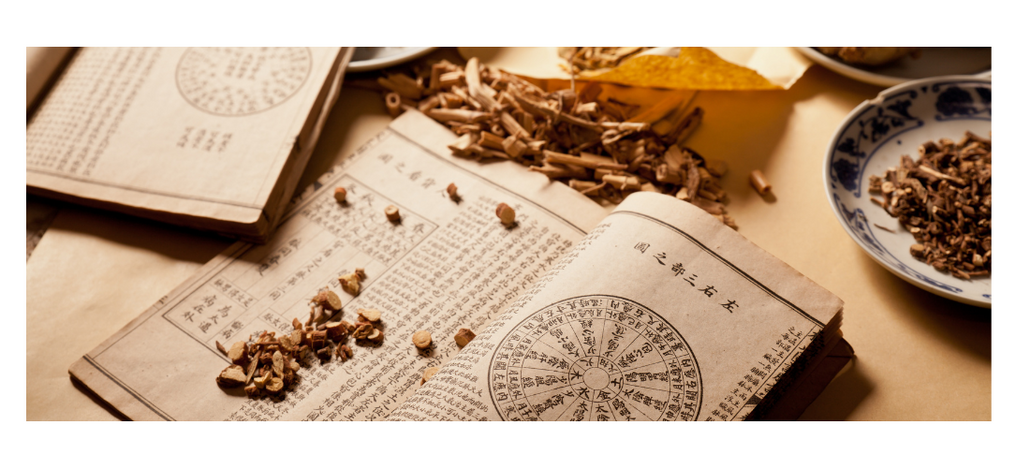From Imperial Scrolls to Everyday Healing: The Rich History of Chinese Herbs—and Why It Still Matters Today
Posted by Sarah Aries Holistic Herbalist on Jul 14th 2025
From Imperial Scrolls to Everyday Healing: The Rich History of Chinese Herbs—and Why It Still Matters Today
Explore the rich, detailed history of Chinese herbs—from ancient dynasties to modern holistic health. Learn how traditional Chinese botanicals evolved, what makes them relevant today, and how to begin using them safely and effectively.
More Than Medicine: A Cultural Legacy

Chinese herbal medicine is far more than a collection of ancient remedies; it is a vibrant, living tradition that has flourished for over 2,500 years. This rich heritage is intricately intertwined with the daily rhythms of food, healing, family life, and the changing seasons. It embodies a holistic philosophy that emphasizes harmony, balance, and the interconnectedness of humanity with nature.
Imagine sipping a warm cup of chrysanthemum tea, its delicate petals unfurling in hot water, releasing a soothing aroma that promotes clarity of mind. Each sip invites you into a world where every ingredient has a purpose and a story. You might find yourself simmering a carefully crafted decoction to aid digestion, combining aromatic herbs with nourishing roots—each selected for its unique properties—to create a healing elixir that has been cherished for generations.
And then there’s Dang Gui, a revered herb that finds its way into women’s tonics, offering support during the menstrual cycle and beyond. This powerful root, known for its ability to nourish the blood, connects you to a tradition that once served emperors and was sought after by travelers along the storied Silk Road. As you blend it into your wellness routine, you are not merely consuming a remedy; you are participating in a millennium-old ritual that transcends time and geography.
Today, Chinese herbs are readily accessible to everyone, from the curious novice to the seasoned practitioner. Yet, the art of using these natural wonders with wisdom and respect requires an understanding of their origins. Appreciating the cultural significance, the historical context, and the meticulous methods of preparation that have been passed down through countless generations is essential.
When you choose to incorporate Chinese herbal medicine into your life, you are embracing a legacy rich with knowledge, reverence, and opportunities for personal growth. It’s an invitation to connect with the past while nourishing your body and soul in the present. Each herb has its own journey—from the lush mountains where it’s harvested to your teacup or tincture—and by honoring this journey, you cultivate a deeper relationship with the healing practices that have stood the test of time.
 The Historical Roots of Chinese Herbal Medicine (with Real Herbs by Era)
The Historical Roots of Chinese Herbal Medicine (with Real Herbs by Era)
Pre-Han Period (Shang – Zhou Dynasties, 1600–221 BCE)
The earliest references to herbs are found not in books—but on oracle bones used in spiritual rituals. Early shamans and healers used plants like Aconite (Fu Zi) and Ephedra (Ma Huang) in divination and healing ceremonies.
These were not yet formulas—they were experiments in balancing the body with nature’s forces: wind, cold, damp, and heat.
Han Dynasty (206 BCE – 220 CE): The Birth of Chinese Materia Medica
The Han Dynasty marks a turning point in herbal use. The text “Shennong Bencao Jing” (Divine Farmer’s Materia Medica) formally documented over 365 herbs, grouped by:
-
Safety level (top, middle, low)
-
Nature (cold, warm, hot, neutral)
-
Taste (bitter, sour, sweet, salty, pungent)
Key herbs first documented:
-
Huang Qin (Scutellaria baicalensis) – clear heat, dry damp
-
Ren Shen (Panax ginseng) – support Qi
-
Gan Cao (Licorice) – harmonize formulas
These herbs weren’t just used—they were classified by energy, interaction, and function, laying the groundwork for modern Traditional Chinese Medicine (TCM)Tang & Song Dynasties (618–1279 CE): Globalization & Standardization
As trade flourished via the Silk Road, herbs like Myrrh, Saffron, and Frankincense were introduced and incorporated into Chinese pharmacopeia.
The Tang Bencao, China’s official herbal compendium, featured 850+ substances with painted illustrations.
At this point, Chinese herbs:
-
Became standardized in dosage and form (teas, powders, pills)
-
Were used in imperial medical colleges
-
Included new herbs from Persia, India, and Central Asia
Ming Dynasty (1368–1644): The Pinnacle of Herb Documentation
Li Shizhen’s “Bencao Gangmu” (Compendium of Materia Medica) changed everything.
This encyclopedia:
-
Cataloged 1,892 herbs (plants, minerals, animals)
-
Included precise preparation methods
-
Explained interactions and side effects
-
Emphasized observation and experimentation
Notable herbs detailed:
-
Dang Gui (Angelica sinensis) – women’s tonic
-
Chuan Xiong (Ligusticum) – moves blood
-
Bai Shao (White peony) – nourishes blood and softens liver
This was the first time Chinese herb usage was presented not just as tradition—but as a science.
Modern Era (1950–Present): Bridging East & West
Today, Chinese herbs are:
-
Used in integrated hospitals across China, Taiwan, and Korea
-
Studied in clinical trials around the world
-
Available globally in forms like teas, tinctures, granules, and capsules
But here’s the catch: the knowledge didn’t always travel with the herbs.
That’s where our website—and education like this—makes a difference.
Then vs. Now: How Herbs Were Used Then... and Now
| Era | Use | Form | Who Used Them |
|---|---|---|---|
| Shang (1600 BCE) | Rituals, cleansing | Raw plant materials | Shamans, nobles |
| Han (200 BCE) | Organ balancing | Decoctions | Physicians, scholars |
| Tang (700 CE) | Disease prevention | Pills, powders | Imperial doctors |
| Ming (1500s) | Complex formulas | Decoctions, plasters | General population |
| Now | Daily wellness, support | Capsules, teas, extracts | Everyone |
Information That You Need To Know
Example using Dang Gui
1. How was this herb originally used?
Dang Gui has been used for over 2,000 years, dating back to the Han Dynasty. It was traditionally prescribed to nourish and move the blood, particularly in women recovering after childbirth, during menstruation, or after blood loss. Ancient physicians viewed it as a cornerstone herb for restoring vitality and balance in the body’s blood system.
In classical texts, Dang Gui was called the “female ginseng” due to its tonifying properties—but modern usage includes both men and women when blood and circulation need support.
2. What formulas was it a part of?
Dang Gui is a key ingredient in several of the most famous Traditional Chinese Medicine formulas, including:
-
Si Wu Tang (Four Substance Decoction) – for blood nourishment
-
Dang Gui Bu Xue Tang (Dang Gui & Astragalus Decoction) – for recovery after blood loss
-
Ba Zhen Tang (Eight Treasure Decoction) – for Qi and Blood deficiency
-
Xiao Yao San (Free & Easy Wanderer Powder) – for stress-related hormone imbalance
These formulas show how Dang Gui is rarely used alone—it harmonizes with herbs like Bai Shao, Chuan Xiong, and Huang Qi to enhance overall effect.
3. What does it taste like? What organ systems does it affect?
Taste: Sweet, pungent, and slightly bitter
Temperature: Warm
TCM Meridians Entered: Liver, Heart, Spleen
Dang Gui’s warm and sweet nature allows it to nourish blood while gently invigorating circulation. It primarily works on the Liver (which stores blood), the Heart (which governs blood), and the Spleen (which produces blood). This synergy helps support hormonal balance, tissue repair, and emotional well-being.
In practical terms, Dang Gui is often recommended when someone feels cold, tired, pale, or emotionally flat due to blood deficiency.
4. Can I use this herb alone or does it need to be paired with others?
While Dang Gui can be taken as a single herb tea or extract, it works best when combined with complementary herbs. Alone, it may provide mild blood nourishment, but it won’t address the root causes of blood deficiency, such as poor digestion or Qi stagnation.
That’s why most TCM practitioners recommend formulas over single herbs. For example:
-
If you're tired and cold: Pair with Huang Qi (Astragalus) for Qi and blood.
If you have cramps: Pair with Chuan Xiong to move blood.
If emotionally unbalanced or stressed: Combine in a formula like Xiao Yao San.
Think of Dang Gui as the lead actor—but it still needs a good supporting cast to perform best.
5. What should I expect? Gentle support or strong action?
Dang Gui provides gentle but steady support—you’ll typically notice improvements over 1–2 weeks, especially when used in a balanced formula. It’s not like caffeine or painkillers; the effects are deep and nourishing, not immediate or jarring.
You may notice better energy, mood, regularity of cycles (for women), and warmer extremities as blood circulation improves.
Real Quotes from Ancient Herbalists
“Herbs act like people. Some are leaders, others support. Together they heal.”
– Zhang Zhongjing, Eastern Han dynasty physician
“Taste reveals the spirit of the herb. Bitter sinks, acrid disperses, sweet nourishes.”
– Bencao Gangmu, 1596
“Why This Still Matters” Consumer Box
✅ Today’s herbal products look modern—but their wisdom is ancient.
When you take an herb like Gou Teng or Bai Zhu, you're using something shaped over centuries—tested not just in labs, but in everyday kitchens, villages, temples, and clinics.
It’s not just a capsule. It’s cultural memory.
And when used with knowledge—it works in harmony with your body.
Internal Linking Suggestions
Thousands of years of tradition. Available in one click
Explore Authentic Chinese Herbs with Full Transparency
Let tradition support your modern health journey—with herbs backed by purity, safety, and purpose.
References:
Dang Gui (Angelica sinensis) – Blood circulation & neuroprotection
Citation & Summary:
-
Danggui significantly reduced cerebral infarction size and improved neurological scores in rats, while enhancing antioxidant enzyme activity in ischemia-reperfusion models Wikipedia+15PMC+15Frontiers+15.
-
Modern reviews highlight its anti-inflammatory, hormone-regulating, and circulatory benefits PMC.
According to preclinical studies, Dang Gui reduced brain damage in ischemic models and boosted antioxidant activity, confirming its traditional role in invigorating blood circulation.
Astragalus (Huang Qi) – Heart health & anti-atherosclerosis
Citation & Summary:
-
Total flavonoids of Astragalus significantly reduced LDL and total cholesterol, increased HDL, and shrank atherosclerotic plaque area in rabbit models Lippincott Journals+5PMC+5ACS Publications+5Bohrium+3PubMed+3Frontiers+3.
-
Its active compound, Astragaloside IV, protected liver and cardiovascular health in mice via anti-inflammatory and lipid regulation mechanisms PubMed+1Frontiers+1.
Research indicates that Astragalus extract can reduce LDL cholesterol and plaque formation in animal studies, while Astragaloside IV helped stabilize plaque and support liver metabolism—supporting its traditional use in cardiovascular care.
Panax ginseng – Metabolic health in humans
Citation & Summary:
-
Clinical groups report that Korean red ginseng improved insulin sensitivity, lowered blood lipids and blood pressure, and reduced inflammatory markers Frontiers+3Frontiers+3PubMed+3PMC+1ClinicalTrials.gov+1.
-
A large meta-analysis confirmed modest but significant benefits in fasting glucose, cholesterol, and inflammatory profiles for prediabetes and metabolic syndrome .
In human trials, Panax ginseng lowered fasting blood glucose, total cholesterol, and inflammatory markers—validating its use in supporting metabolic health and energy regulation.
Dang Gui + Chuan Xiong Pair – Synergistic synergy for blood stasis
Citation & Summary:
-
A systems study found the Dang Gui–Chuan Xiong herb pair significantly enhanced blood circulation and relieved stasis in lab animals Europe PMC+5ACS Publications+5Medical News Today+5.
Dang Gui, historically used to nourish blood, was shown in modern rat models to reduce ischemic damage and improve antioxidant enzyme activity Europe PMC+2Medical News Today+2ACS Publications+2.
*Astragalus’ total flavonoids lowered LDL and plaque size in rabbit studies ACS Publications+15PubMed+15Frontiers+15.
In clinical trials, Korean red ginseng improved glucose control, lipid metabolism, and reduced inflammation in metabolic syndrome patients Wikipedia+8PMC+8ClinicalTrials.gov+8.
The Dang Gui–Chuan Xiong formula continues to prove effective at improving blood stasis, as validated in metabolomic profiling Europe PMC+6ACS Publications+6PMC+6.

